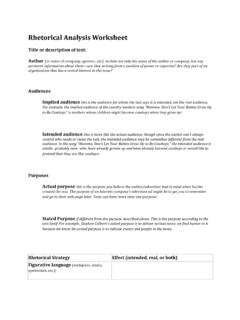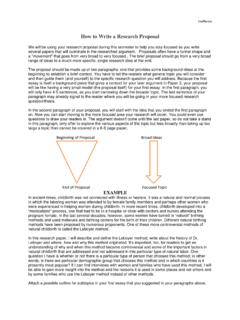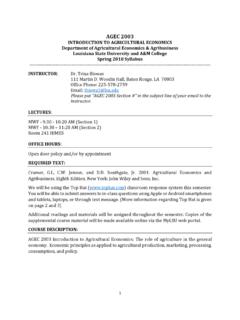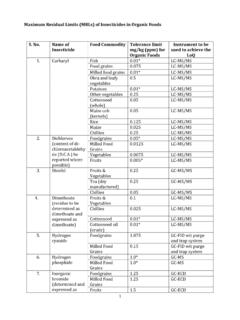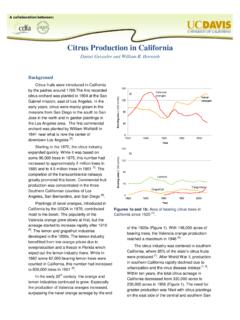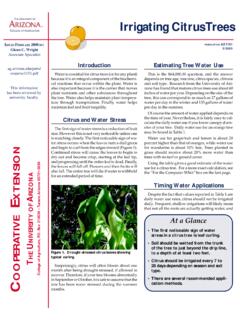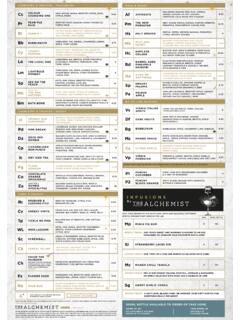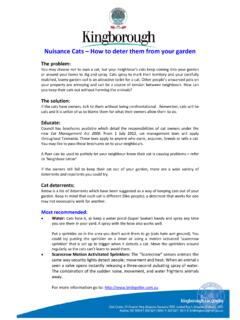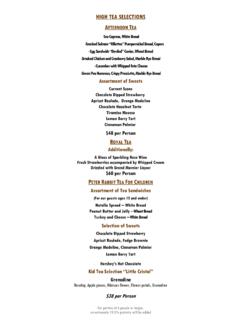Transcription of Transportation of Fresh Produce
1 Moving Fresh Produce between the point of origin and point of use requires multiple Transportation steps. Produce is susceptible to physical or chemical damage as well as microbial contamination during affecting Fresh Produce safety during transportation1 . Produce quality: fruit and vegetables, especially soft-skinned or succulent Produce such as tomatoes, leafy greens and peaches, are more susceptible to cross-contamination by plant and human pathogens. Damaged, diseased or over-ripe fruit should not be transported. Remove it from shipping containers before transporting other.
2 Temperature and humidity: Temperature and humidity play key roles in the safety of Produce and other foods. Many pathogens grow rapidly when temperatures are between 40 and 140 degrees Fahrenheit; which is known as the temperature danger zone. Cooling Produce as soon as it is harvested and keeping it cool during storage and Transportation will slow the growth of many pathogens that are present on the Produce . Recommended storage and Transportation temperatures for a variety of vegetables are listed in the accompanying table (Table 1).General Transportation considerations:Vehicles All Transportation vehicles must be suitable for the purpose, in good physical condition, dry (no dripping or standing water), well maintained and clean.
3 Inspect all vehicles and containers for debris, soil and odors prior to loading. Transport and store Produce in vehicles and containers that are dedicated to carrying food products. Do not transport Fresh Produce in a truck that has been used to transport live animals, animal parts, soil or chemicals. Do not transport pets in vehicles used to transport Fresh Produce . All Transportation vehicles must be pest-free. All Fresh Produce Transportation vehicles must be washed with water at 140-160 F and sanitized with a food-grade sanitizer prior to loading and transporting of Fresh Produce .
4 Best Practices To Ensure On-farm Food SafetyRecommended Temperature Range (degrees Fahrenheit) and Relative Humidity (percentage)VegetablesFruits32-36 F90-98 percentBroccoli, cabbage, kale, leeks, lettuce, mustard greens, peas and turnip greensBlackberries, blueberries, cantaloupes, cut fruits, figs, peaches, persimmons, quince, raspberries and strawberries45-50 F85-95 percentBasil, beans, southern peas, cucumbers, eggplants, okra, peppers, summer squash and tomatillosCitrus, passion fruit and watermelons55-65 F85-95 percentPumpkins, winter squash, sweet potatoes and tomatoes (ripe, partially ripe and mature green)Honey dew melonsTable 1.
5 Recommended storage and Transportation conditions (temperature and relative humidity ranges) for various vegetables and fruits. Keep Produce refrigerated at temperatures appropriate for the Produce type (See Table 1.) during storage and Transportation , and during sale, to minimize the potential for growth of microbial pathogens. Refrigerated trucks or containers should be equipped with accurately calibrated thermometers for monitoring temperatures. A thermometer that displays the range of temperatures over a set time period, also known as a minimum/maximum thermometer, is recommended.
6 Inspect cooling systems before each trip to ensure they are working properly. Place Produce and/or containers in a manner that allows for proper air circulation. All pallets used in the vehicle must be dry, clean and free from damage or visible infestations. Fresh -cut or packaged Produce must not come into direct contact with the vehicle All workers involved in the loading and unloading of Fresh Produce must be healthy and follow appropriate personal hygiene practices. Drivers and other Transportation and handling personnel must be educated about established food safety procedures.
7 Workers should load and unload Produce in a manner that minimizes the potential for damage or microbial and record keeping Standard operating procedures for all Transportation practices should be developed and available to all to workers. Document the following practices: Temperature and humidity of refrigerated vehicles. Thermometer calibrations. Vehicle inspections. Educational sessions for workers. Vehicle cleaning and sanitation (including water temperatures and/or products used and concentrations)ReferencesThompson, J., A. Kader, and K. Sylva. 1996. Compatibility chart for fruits and vegetables in short-term transport or storage.
8 Oakland: University of California Division of Agriculture and Natural Resources Publication B. Richardson, LSU Vice President for AgricultureLouisiana State University Agricultural CenterLouisiana Agricultural Experiment StationLouisiana Cooperative Extension ServiceLSU College of (Online Only) 9/15 The LSU AgCenter and LSU provide equal opportunities in programs and fact sheet was developed as part of the LSU AgCenter Good Agricultural Practices Project. This project was funded by Louisiana Department of Agriculture and Forestry SCBG Project No. 734147 Malekian, , Southern University Agricultural Research and Extension CenterAchyut Adhikari, , LSU AgCenter School of Nutrition and Food Sciences Charles Graham, , LSU AgCenter Pecan Research-Extension StationKathryn Fontenot, , LSU AgCenter School of Plant, Environmental and Soil SciencesMelanie L.
9 Lewis Ivey, , LSU AgCenter Department of Plant Pathology and Crop Fresh Produce . Photo by Mila Berha

